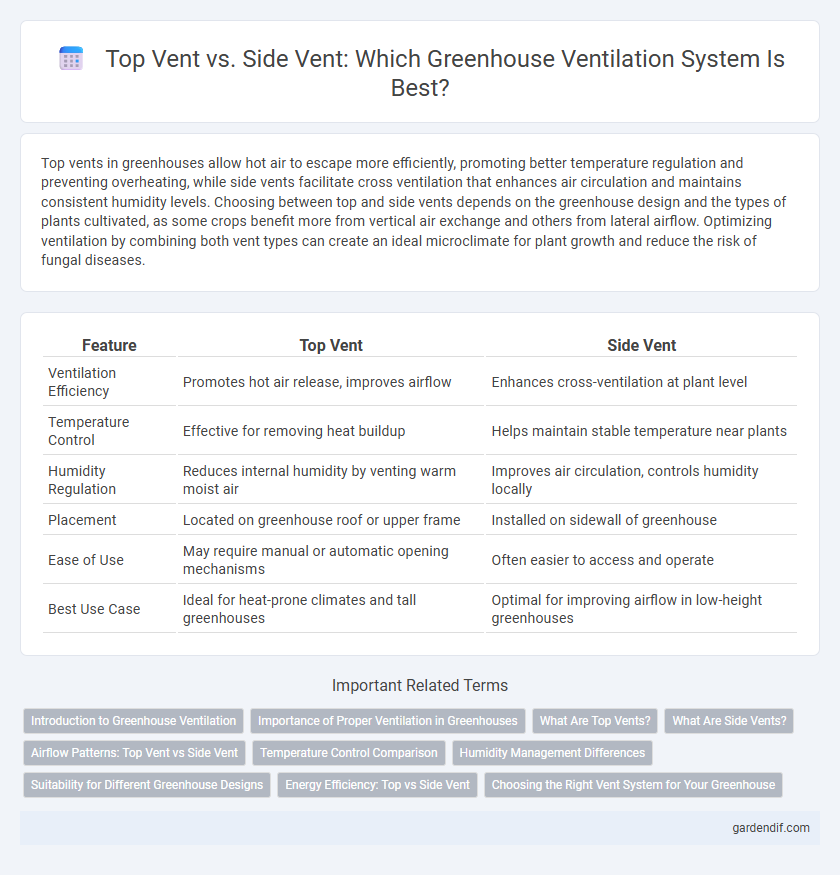
Top vent vs Side vent Illustration
Top vents in greenhouses allow hot air to escape more efficiently, promoting better temperature regulation and preventing overheating, while side vents facilitate cross ventilation that enhances air circulation and maintains consistent humidity levels. Choosing between top and side vents depends on the greenhouse design and the types of plants cultivated, as some crops benefit more from vertical air exchange and others from lateral airflow. Optimizing ventilation by combining both vent types can create an ideal microclimate for plant growth and reduce the risk of fungal diseases.
Table of Comparison
| Feature | Top Vent | Side Vent |
|---|---|---|
| Ventilation Efficiency | Promotes hot air release, improves airflow | Enhances cross-ventilation at plant level |
| Temperature Control | Effective for removing heat buildup | Helps maintain stable temperature near plants |
| Humidity Regulation | Reduces internal humidity by venting warm moist air | Improves air circulation, controls humidity locally |
| Placement | Located on greenhouse roof or upper frame | Installed on sidewall of greenhouse |
| Ease of Use | May require manual or automatic opening mechanisms | Often easier to access and operate |
| Best Use Case | Ideal for heat-prone climates and tall greenhouses | Optimal for improving airflow in low-height greenhouses |
Introduction to Greenhouse Ventilation
Top vent and side vent systems both play crucial roles in greenhouse ventilation by regulating temperature, humidity, and airflow to create optimal plant growth conditions. Top vents facilitate hot air escape and promote natural convection, while side vents allow cooler air intake, ensuring continuous circulation. Selecting the appropriate vent combination influences energy efficiency and crop yield in controlled-environment agriculture.
Importance of Proper Ventilation in Greenhouses
Proper ventilation in greenhouses is crucial for regulating temperature, humidity, and air quality to promote optimal plant growth. Top vents facilitate the escape of hot air and humidity from the upper area, preventing heat stress, while side vents enable cooler air to enter and circulate, ensuring even temperature distribution. Combining top and side vents enhances airflow efficiency, reduces the risk of fungal diseases, and supports photosynthesis by maintaining consistent environmental conditions.
What Are Top Vents?
Top vents in greenhouses are openings located on the roof that facilitate hot air escape and promote natural ventilation, crucial for regulating temperature and humidity. These vents enhance airflow by allowing warm air to rise and exit, preventing heat buildup and encouraging fresh air circulation. Optimal placement and size of top vents are essential for maintaining a stable growing environment for plants.
What Are Side Vents?
Side vents in greenhouses are openings located along the walls that allow for effective air circulation and temperature control by promoting cross-ventilation. These vents help regulate humidity levels and reduce heat buildup by letting cooler air enter and warmer air escape horizontally. Compared to top vents, side vents provide easier access for adjustable airflow and improve overall plant health by maintaining stable growing conditions.
Airflow Patterns: Top Vent vs Side Vent
Top vent placement in greenhouses promotes upward airflow, allowing hot air to escape efficiently and enhancing vertical air circulation. Side vents facilitate horizontal airflow, which helps in drawing fresh air across the plant canopy and reducing humidity at lower levels. Combining top and side vents optimizes overall airflow patterns, improving temperature regulation and preventing stagnant air pockets.
Temperature Control Comparison
Top vents in greenhouses excel at releasing hot air due to natural convection, maintaining cooler temperatures more effectively during warm days. Side vents promote cross-ventilation by drawing in cooler air at lower levels, enhancing airflow and preventing heat buildup. Combining both vent types allows optimal temperature regulation by balancing hot air exhaust from the top and fresh air intake from the sides.
Humidity Management Differences
Top vents in greenhouses allow hot, humid air to rise and escape efficiently, promoting superior humidity control and reducing condensation risks. Side vents facilitate cross-ventilation, enhancing air exchange but may be less effective in releasing accumulated humid air at higher levels. Combining top and side vents optimizes humidity management by balancing heat removal and air circulation.
Suitability for Different Greenhouse Designs
Top vents optimize heat escape and are ideal for taller, traditional greenhouse designs requiring efficient temperature regulation. Side vents promote cross-ventilation, making them suitable for larger or wider greenhouses where airflow distribution is crucial. Choosing between top and side vents depends on structural height, greenhouse size, and desired airflow patterns for plant health.
Energy Efficiency: Top vs Side Vent
Top vent greenhouses optimize energy efficiency by facilitating natural heat release and improved air circulation, reducing the need for mechanical cooling. Side vent designs can promote cross-ventilation but may allow more heat loss during colder months, impacting energy conservation. Strategic placement and automation of vents enhance temperature regulation, directly influencing heating and cooling energy demands.
Choosing the Right Vent System for Your Greenhouse
Choosing the right vent system for your greenhouse depends on factors like airflow efficiency and temperature control. Top vents enhance heat release by allowing hot air to escape naturally, making them ideal for hot climates, whereas side vents promote horizontal airflow, improving ventilation in cooler or hybrid conditions. Combining both vent types optimizes air circulation, supporting balanced temperature and humidity levels essential for plant health.
Top vent vs Side vent Infographic

 gardendif.com
gardendif.com